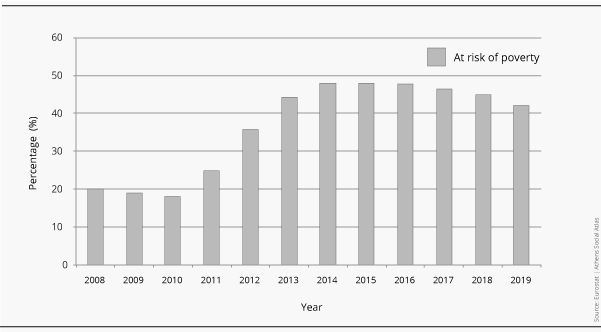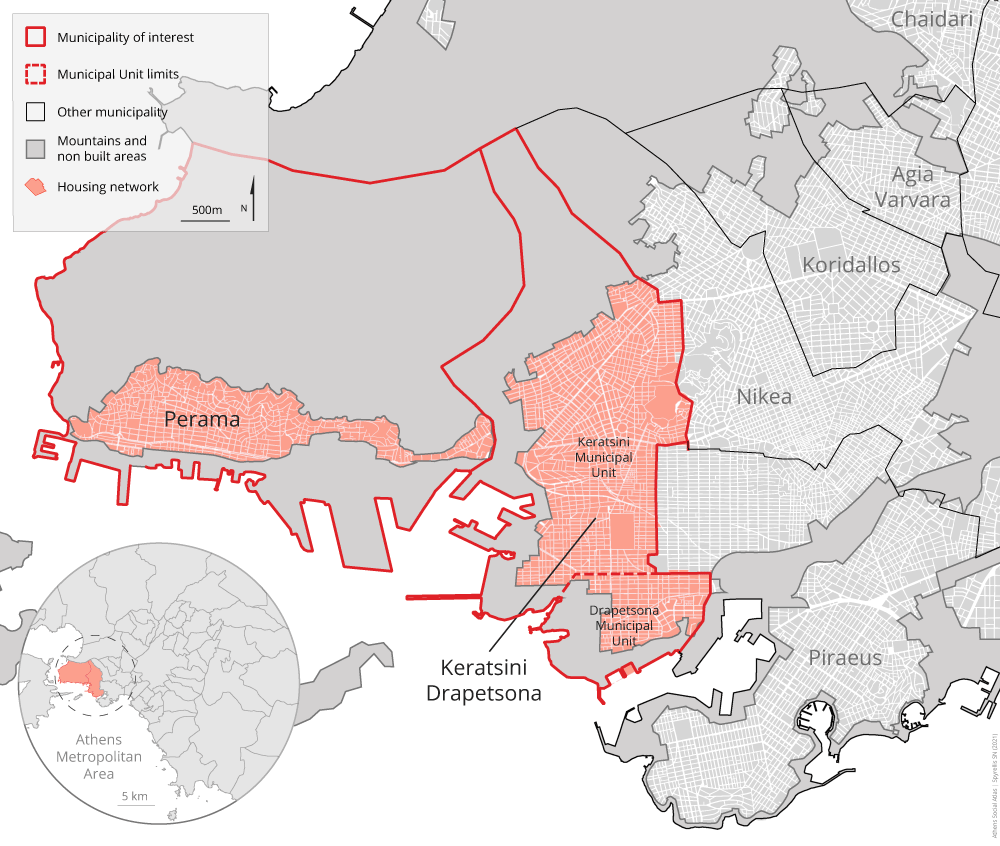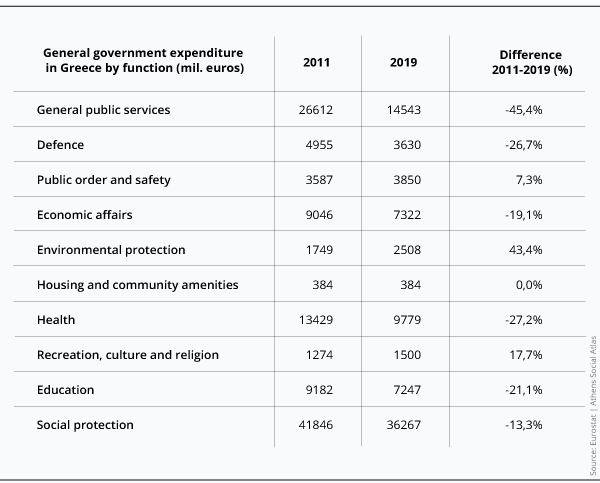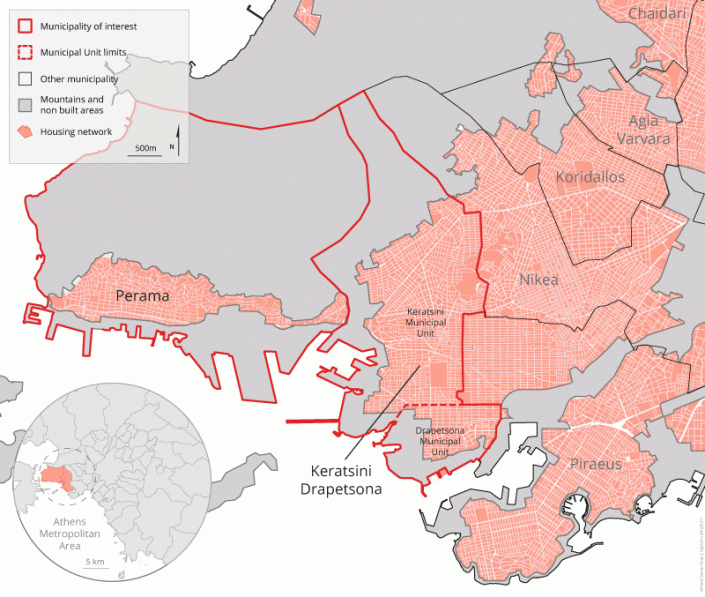Regulating the poor. The Greek Guaranteed Minimum Income
Burgi Noëlle|Kyramargiou Eleni
Economy, Politics
2021 | Nov
On 1 February 2017, a guaranteed minimum income (GMI) [1]. was rolled out across Greece following two pilot tests in 2014-2015 and in 2016. GMIs are assistance schemes entailing means tested regular non-contributory cash benefits to households identified as poor. The GMI was sorely needed in a country with a weakly, both formal and informal, redistributive social protection system. It selectively covered the needs of some categories of the population, mainly in the public sector, leaving the family, solidarity networks and small scale businesses make up for the shortfall in social policy (Lyberaki and Prontzas, 2015; Petmesidou and Mossialos, 2006). This fragmented and unfair system was not designed to cushion the social consequences of the economic changes of recent decades, much less so those of the “internal devaluation” (wage cuts, tax increases, cuts in public services, deregulation of the labour market, etc.) of the 2010s. Indeed, Greece is the European country most hit by the Great Recession triggered by the 2008 financial crisis, and by three structural adjustment programmes (2010, 2012, 2015) that led to a forced and prolonged economic and social depression. Figure 1 shows a collapse of GDP of great amplitude starting in 2008, rare in peacetime conditions.
Figure 1: Quarterly GDP at 2010 prices
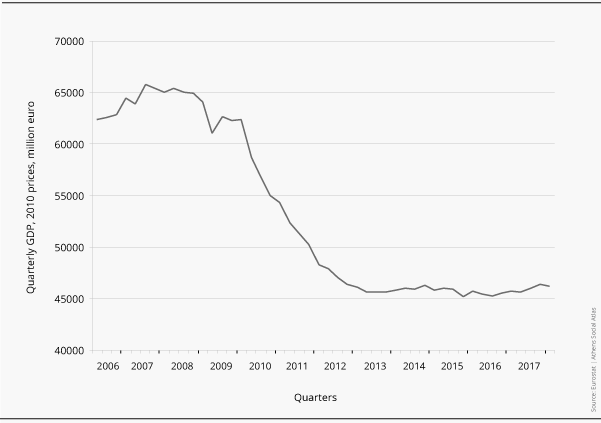
As a result, there has been a dramatic increase of poverty, both relative and extreme [2]. Population at risk of poverty and social exclusion rose from 20% in 2008 to well over 48% in 2015 and in 2019 hovers just above 40% (2008 being the baseline) (figure 2). Available studies indicate for 2015 and 2017 that about 15% of Greeks were extremely poor (they were 2.2% in 2009) (Matsaganis et al., 2016; World Bank [WB] 2019).
Figure 2: At risk of poverty rate anchored 2008
This paper presents some results of a case study carried out over the period 2017-2019 by the authors in the Piraeus regional unit [3]. We investigated the implementation of the GMI in Keratsini-Drapetsona and Perama, two municipalities hard hit first by a long phase of deindustrialisation, and thereafter by the Great Recession of the 2010s. The research focused on the management of the scheme, on the beneficiaries’ perceptions of the support provided by the programme and the resulting improvements, if any, in their daily lives. Data relating to the GMI were gathered through iterative field observations at the social services and 43 semi-structured (some of them serial) interviews throughout the period with mayors and the municipal staff, NGO workers, community activists and local agents engaged in solidarity structures (such as food distribution and defence of over-indebted people) and with some national level agents. We also talked informally (without recording the conversations) with beneficiaries during their waiting periods on the sites of the social services and interviewed precariously employed people (identified by the snowball method). Interviews were usually face-to-face, mostly involving the two researchers. The study also relied on a desk review of International Organisations’ reports, on primary and secondary sources and on macro-statistical indicators.
Map 1: The zone of interest
Extending the case study
We interpreted our data using the extended case study method (Burawoy, 1998) in order to highlight the interconnection between external social forces (the European and international context) and social developments in the two municipalities. Indeed, the Greek GMI is part of a global and European framework for (re)constructing social protection policies following the deleterious effects of structural adjustment programmes in the South (e.g. the Lost Decade in Latin America), and the emergence of new risks and needs arising from fundamental changes in the labour market and ageing populations. Sometimes referred to as a paradigm shift (Hemerijck, 2018) from the neoliberal approach exclusively focused on the market and reduced public spending, a new “pro-poor” development model became consensual in the 2000s among major supra- and international organisations. It spread in the South as well as in the North, fuelled by the growing involvement and influence of the World Bank in the field of social policies (Deacon, 2007). Based on the concept of social investment [4], this model aims to prevent or alleviate poverty and social exclusion by reducing the coverage gaps between “insiders” and “outsiders” while reaffirming (and reinventing) the principle of universality of social protection [5].
The new global model
At the base of the new architecture, Social Protection Floors (SPFs) (ILO, 2012) or their European equivalent, the 2017 European Pillar of Social Rights [6] guarantee minimum benefits for the poor, among which GMI-type solidarity income and labour market activation programmes play a key role. The WB and the EU see Floors as the substructure of “universal social protection” (USP) systems in which different types of public, private or community schemes protect different groups against specific risks over the life course (ILO and WB, 2015). Thus, it would be possible to limit and rationalise public spending cutting back on social spending deemed unproductive and redirecting available funds to those categories of the population that promise to have the greatest impact on future economic growth: on children to break the cycle of poverty transmission, on women and, beyond that, on marginalised fractions of society that lack the resources to cope with hardship and “new risks”. This “investment” is supposed to have a ”springboard” effect: it would allow the poor to become “risk-takers” in the market and thereby contribute to economic development (WB, 2001).
According to the institutional literature, Floors and Pillars have ambitious normative objectives. They aim to empower the poor, promote a better life and health for all in dignity, and rebuild stronger and more cohesive societies less prone to shocks. Yet, do the schemes created to this end really achieve, or at least come close to these goals? This fundamental issue underpins our research.
The Greek GMI Programme
The Greek GMI programme is organised around three “pillars” corresponding to (1) a regressive allowance not exceeding € 200 for one person, €100 for each additional adult and €50 per minor child; (2) in-kind social benefits (food distribution, discounts on electricity bills, access to public healthcare); (3) and job-seeking assistance. GMI applications are carried out by the social services or community centres at the municipalities or directly by claimants. They are processed through a computer programme capable of cross-referencing online data, that is, verify and validate information through several electronic platforms and identify the applicant through the tax return system. The platform is constantly updated to incorporate knowledge (other online data, errors or failures detected through regular inspections, information from municipalities, evaluations, seminars, and so on).
Eligibility criteria vary according to the size of the household. Income during the six months preceding the application must not exceed six times the amount of the allowance (e.g. €1,200 for a single person); criteria for ownership include the taxable value of real estate, the objective value of all types of private vehicles, and total bank or cash deposits (a ceiling of €4,800 for a single person). These very restrictive eligibility criteria are meant to cover about 7 percent of the population under the threshold of extreme poverty (the 15 percent “extreme poor”) (WB, 2019a; for comprehensive accounts, see among others Lalioti, 2017; Dimoulas, 2018; Sakellaropoulos et al 2018, 2019).
A considerable challenge
From a strict policy management perspective, this scheme represents a breakthrough. It rationalises social protection using a technology that did not exist in Greece, targets the poor who were previously largely deprived of social protection, and provides them with meagre relief through cash and in-kind transfers. Moreover, according to the OECD’s Government at a Glance 2021 dataset (Figure 3), government expenditures for social protection declined 13.3% between 2011 and 2019 (from € 41.846 billion to € 36.267 billion) notwithstanding the specific expenditures for the GMI programme (€ 501 million in 2019). However, does budgetary rationalisation and in particular the redeployment of social protection expenditure towards the extremely poor qualitatively improve their living conditions?
Figure 3: Public expenditure by function
The stakes are high for the populations targeted by the scheme. Reliable statistical data on living conditions, precariousness and poverty in the municipalities of West Piraeus are not available because the current population census (2021), which should include a lot of local data, has not been completed and cannot yet be compared to the previous one (2011). However, important recent anthropological research (Spyridakis, 2013, 2018; Bithymitris, 2016) has explored the trajectories and hardships suffered by the populations dependent on the shipbuilding and repair Zone of the port of Piraeus, the main employment area, and describes social situations that we also observed or that were reported to us during our survey. From the 1980s onwards, the disappearance of activities directly or indirectly linked to the shipyards and the destruction of other activities located in Piraeus (tobacco, textiles, fertilisers, metallurgy, flour mills, etc.), followed by the structural adjustment policies of the 2010s, have unraveled the economic, professional, social and family environment of the workers and merchants of this sub-region, where demand for labour is now very limited, while the labour reserve is over-abundant. Small shop-keepers are proletarianised, over-indebtedness crosses the social classes, and families are dissociated.
Accessibility and non-discrimination
The improvement of living conditions raises a first important issue: are needy citizens treated fairly “solely on the basis of their poverty status and without categorical exclusions” (WB, 2019a)? Reformulated from a normative perspective, this question addresses one of the core contents of USP: its accessibility. Accessibility means, among other requirements, that programmes must be based on the principles of non-discrimination and equality. For only those “mainstream”vulnerable groups who reached the social services during our study (the most marginal ones tend to be left by the wayside), a few observations are worth mentioning.
Means-tested schemes are individualised mass management technologies: the “poor masses” (a “universal” category), are processed by addressing each individual situation. Reconciling the particular and the universal is a difficult conceptual problem to solve. We observed and/or were told that mismatch situations between welfare-seekers’ accounts and online information often occur. Causes greatly vary, one of them being that the margin of error of the information system in determining eligibility is quite large. In such situations, past experience in social services plays an important role, both because employees received only summary training merely to operate the computer programme (many are unable to read and understand tax returns, which are key documents in handling applications), and because they have substantial discretionary power in processing applications.
As a result, practices vary from inexperienced and poorly educated employees who simply follow the instructions on their screens, to those who dig deeper. In addition, targeting mechanisms introduce arbitrary differences between recipients. For example, why is a disability allowance paid by the state combined with a GMI allowance when the same benefit paid by a social insurance is not? Why is the child allowance (€70) deduced from GMI allowances, when USP is designed to invest first and foremost in children? The assessment of individual situations is so complex that the authorities have even introduced dubious judgement criteria such as outward signs of wealth (perhaps inherited from a brighter past) to detect suspected fraudulent behaviours. Many more examples could be provided. Thus, political considerations underlying the classification of social groups and problems inherent in means-tested technologies result in infringements of anti-discrimination principles.
A “productive“ shadow economy?
Two other core contents of USP—availability of sustainable social protection mechanisms, and adequacy of basic welfare entitlements (“in amount and duration for everyone to realise his/her rights”)—lead a discussion on the amounts of cash transfers and work.
Most researchers and experts, as well as national officers and the social workers we spoke to, note that income transfer levels are so stringent that most GMI recipients will “not make it over the [relative] poverty line” (WB, 2019a). Likewise, they regret that Pillar 3 (labour market activation) is deficient. It is indeed questionable whether absolute minimum benefits in cash or kind such as those offered by the GMI are likely to empower and enhance the and capabilities of the poor in the sense of human development. With this in mind, the debate usually evolves around three main issues: undeclared work, the need to strengthen the Greek Manpower Employment Organisation (OAED), and the impossibility to increase the amounts of cash benefits both because allowances at less than low wages are supposed to make work attractive, and for budgetary reasons.
This conversation seems fruitless for several reasons. First, the budgetary arguments put forward by the authorities are unassailable due to the asymmetry of international power relations. Greece is still subject to an enhanced surveillance regime and has no fiscal room for manoeuvre. The 2015 memorandum prescribed a “fiscally neutral” social protection system which implied financing the scheme by achieving primary budget surpluses through social spending cuts and tax increases. The IMF and the EU exclude the possibility of a more substantial redistribution, for example by transferring part of the defence budget to social protection. Therefore, the inadequacy of the solidarity income in relation to the possibilities of human development calls for a reflection on the need for a Global Fund (if only a European Fund) for social protection to finance Floors in poorer countries (de Schutter and Sepúlveda, 2012).
Second, as we were repeatedly told, “everyone knows that everybody is moonlighting”. Undeclared work (and more broadly the underground economy, which concerns both low and high earners) has always been a structural feature of the Greek economy. It may also be considered a structural feature of GMI assistance, which is insufficient for the poorest to live on. Third, the authorities are doing their best to step up Pillar 3, using standard public policy instruments such as registration with the OAED and public employment programmes. The latter include non-renewable six to eight months fixed-term contracts paid around €500 monthly if full time, €250 if part-time. These amounts parallel the low wages offered on the market and do not generate the conditions for substantive improvements of people’s lives. In addition, back-to-work schemes, which are supposed to improve the employability of the unemployed, are not a panacea. In the particular case of workers in the Zone, especially those over 40, they have always been confronted with a structurally flexible labour market, with casual and precarious employment. Having struggled for their daily wages, they know how to look for work and change their employment status according to the opportunities that arise. What then is the point of extolling the superior value of incentive-based activation policies?
The WB has answers to that. Its core idea, which practically also seems to be the EU’s, is that the poor are a productive factor that should contribute to economic development, regardless of whether they do so in the informal sector—defined as labour and business that is hidden from monetary, regulatory, and institutional authorities. The Bank now sees that sector as a potential “engine for growth” (WB, 2019b). Once it is considered as such, informal employment becomes a relatively tolerable complement to devices such as public work programmes, which are a strong alternative model to unconditional cash transfers for the poor.
Concluding remarks
Further research is needed assess how the shadow economy is driven by but also fuels social vulnerability. If, as GMI beneficiaries often say, the allowance is “at least something”, it only involves adaptations to current degraded socio-economic conditions rather than their transformation. In Greece, large but differentiated vulnerable populations are not being given the means to live decent and meaningful lives, the cash transfer and other mechanisms being tailored to other purposes.
[1] Also known as social solidarity income—KEA in Greek—before January 2021.
[2] Relative poverty refers to annual incomes below 60% of national median disposable income. Extreme poverty in the case of the GMI refers to incomes below the 40% threshold, i.e. annual incomes not exceeding €2,880 in 2017 (WB, 2019a).
[3] This research was supported by the French School of Athens
[4] There is an important literature on social investment. See e.g. Jenson (2010) and Jenson and Saint-Martin (2003). Interestingly, the concept has now entered the public debate in Greece (Matsaganis, 2021)
[5] ILO and WB(2015). For a more detailed analysis, see Burgi and Kyramargiou, 2021.
[6] See https://ec.europa.eu/info/strategy/priorities-2019-2024/economy-works-people/jobs-growth-and-investment/european-pillar-social-rights/european-pillar-social-rights-20-principles_el
Αναφορά λήμματος
Burgi, N., Kyramargiou, E. (2021) Regulating the poor. The Greek Guaranteed Minimum Income, in Maloutas T., Spyrellis S. (eds) Athens Social Atlas. Digital compendium of texts and visual material. URL: https://www.athenssocialatlas.gr/en/article/regulating-the-poor/ , DOI: 10.17902/20971.104
Αναφορά Άτλαντα
Μαλούτας Θ., Σπυρέλλης Σ. (επιμ.) (2015) Κοινωνικός άτλαντας της Αθήνας. Ηλεκτρονική συλλογή κειμένων και εποπτικού υλικού. URL: https://www.athenssocialatlas.gr/ , DOI: 10.17902/20971.9
References
- Bithymitris, G. (2018), “Collective Identity Under Reconstruction: The Case of West Piraeus (Greece)”, in C. Karner, B. Weicht (eds.), The Commonalities of Global Crises : Markets, Communities, and Nostalgia, London, Palgrave Macmillan, p. 167-193.
- Burgi, N, and Kyramargiou E. (2021) The elusive promise of Universal Social Protection : The case of the Greek General Minimum Income (GMI). International Journal of Sociology and Social Policy,Volume ahead of print. doi: https://doi.org/10.1108/IJSSP-11-2020-0497
- De Schutter, O., and Sepúlveda, M. (2012). Underwriting the Poor: A Global Fund for Social Protection. Briefing Note 07, October.
- Deacon B., with Hulse M. and Stubbs P. (1997), Global Social Policy: International Organizations and the Future of Welfare, Sage, London.
- Δημουλάς Κ. (2018). Κρίση και κοινωνικό εισόδημα αλληλεγγύης. Στο Κ. Δημουλάς και Γ. Κουζής, Κρίση και Κοινωνική Πολιτική. Αθήνα: Τόπος.
- Hemerijck A. (2018). “Social investment as policy paradigm”. Journal of European Public Policy, Vol. 25 N°6, pp.810-827.
- ILO (2012), “R202: Social Protection Floors Recommendation, 2012 (N°202).” 101st International Labour Conference session. https://www.ilo.org/dyn/normlex/en/f?p=NORMLEXPUB:12100:0::NO::P12100_ILO_CODE:R202 (last accessed 31.10.2020).
- ILO and World Bank Group (2015), “A shared mission for universal social protection”. Concept Note. https://www.ilo.org/wcmsp5/groups/public/—dgreports/—dcomm/documents/genericdocument/wcms_378996.pdf (Last accessed 31.10.2020).
- Jenson J. (2010), “Diffusing Ideas for After Neoliberalism: The Social Investment Perspective in Europe and Latin America”, Golbal Social Policy, Vol. 10, N°1, pp.59-84.
- Jenson J. and Saint-Martin Denis (2003), “New Routes to Social Cohesion? Citizenship and the Social Investment State”, The Canadian Journal of Sociology / Cahiers canadiens de sociologie, Vol. 28 N°1, pp.77-99.
- Λαλιώτη Β. (2017). Ελάχιστο Εγγυημένο Εισόδημα, Το χρονικό ενός «πολυαναμενόμενου» αναγγελθέντος μέτρου, Τετράδια Κοινωνικής Πολιτικής n°2. Αθήνα: Gutenberg.
- Lyberaki A, and Prontzas E. (2015) “Informal Social Protection, the Hybrid Social State and the Dynamic Evolution of the Economic Crisis in Greece”, https://ec.europa.eu/eurostat/cros/system/files/aristeia_final_version_november2015_all_parts.pdf.
- Ματσαγγάνης Μ., Λεβέντη Χ., Καναβίτσα Ε. Και Φλεβοτόμου Μ. (2016). Μια Αποδοτικότερη Πολιτική για την Καταπολέμηση της Ακραίας Φτώχειας. Αθήνα : Διανέοσις.
- Matsagganis M. (2021) “The welfare state as an accelerator of sustainable development”, Dianeosis . https://www.dianeosis.org/wp-content/uploads/2021/06/welfare_state_matsaganis.pdf.
- Petmesidou, M., and Mossialos, E. (eds) (2006), Social Policy Developments in Greece, Aldershot, Ashgate.
- Σακελλαρόπουλος Θ., Οικονόμου Χ., Σκαμνάκης Χρ., Αγγελάκη Μ.,(επιμ.) (2018). Κοινωνική Πολιτικη. Αθήνα: Διόνικος.
- Sakellaropoulos, T., Lalioti, V., & Kourachanis, N. (2019). ‘The Social Impact of the “Social Solidarity Income” in Greece: A Qualitative Interpretation’. Social Cohesion and Development, vol. 14, no 1, pp. 5-20.
- Spyridakis, M. (2018), Homo Precarius: Εμπειρίες ευαλωτότητας στην κρίση, Athens: Pedio
- Spyridakis, M. (2013), The liminal worker. An ethnography of work, unemployment and precariousness in contemporary Greece, Farnham: Ashgate.
- World Bank (2019a), A Quantitative Evaluation of the Greek Social Solidarity Income. World Bank, Washington DC.
- World Bank (2019b), Global Economic Prospects. Darkening Skies. World Bank, Washington DC.
- World Bank (2001) Social Protection Sector Strategy: From Safety Net to Springboard, World Bank, Washington DC. http://documents1.worldbank.org/curated/en/299921468765558913/pdf/multi-page.pdf (last accessed 31.10.2020).

